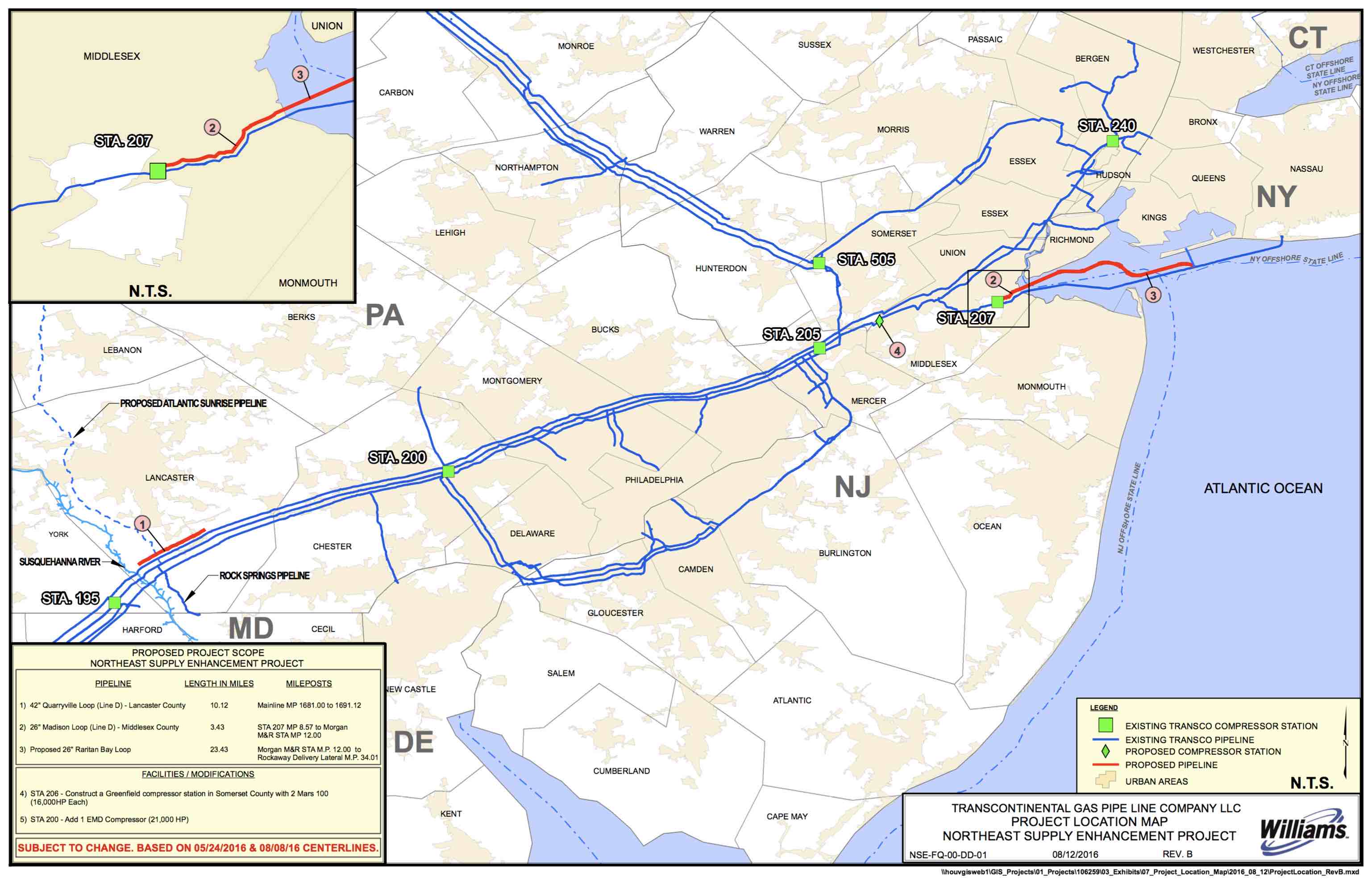Draft EIS Issued for Northeast Supply Enhancement Project

The Federal Energy Regulatory Commission (FERC) today issued a draft environmental impact statement (EIS) for the Northeast Supply Enhancement Project proposed by Williams, which would provide about 400,000 dekatherms per day of natural gas to end-use residential and commercial customers in the New York City area and includes the following:
- 10.2 miles of 42-inch-diameter pipeline loop in Lancaster County, Pennsylvania (Quarryville Loop)
- 3.4 miles of 26-inch-diameter pipeline loop in Middlesex County, New Jersey (Madison Loop)
- 23.5 miles of 26-inch-diameter pipeline loop in Middlesex and Monmouth Counties, New Jersey, and Queens and Richmond Counties, New York (Raritan Bay Loop)
- Modification of existing Compressor Station 200 in Chester County, Pennsylvania
- Construction of new Compressor Station 206 in Somerset County, New Jersey
- Ancillary facilities, including cathodic protection systems, new and modified mainline valves with tie-in assemblies, new and modified launcher/receiver facilities, and facilities to connect the Raritan Bay Loop to the existing Rockaway Delivery Lateral at the Rockaway Transfer Point
According to the EIS, FERC staff determined that construction and operation of the project would result in some adverse temporary offshore environmental impacts related to turbidity, sedimentation, and pile driving noise, and for residences in the area. Also, long-term impacts on air quality and noise would result from the operation of Compressor Station 206. However, if impact avoidance, minimization, and mitigation measures are implemented, along with adherence to recommendations from FERC staff, all environmental impacts from the project would be reduced to less-than-significant levels.
Although many factors were considered, reasons given for this determination include:
- The Quarryville and Madison Loops would be collocated with existing facilities for 97 percent and 100 percent of their lengths, respectively, with a typical offset of 25 feet from existing pipelines. Some workspace needed to construct the loops would overlap with Williams’ current right-of-way, reducing construction-related impacts.
- A high level of public participation was achieved during the pre-filing and post-application review processes and helped inform our analysis.
- Compressor Station 206 would comply with operating air permit conditions, and emissions would meet the National Ambient Air Quality Standards and other applicable standards that are protective of public health and welfare. Operating noise from the facility would meet our requirements at noise sensitive areas and the facility would be visually screened from surrounding viewpoints. All project facilities, including Compressor Station 206, would be designed, constructed, operated, and maintained in accordance with U.S. Department of Transportation safety requirements that are protective of public safety.
- The proposed route and construction methods for the Raritan Bay Loop were developed in consultation with the USACE and other agencies to minimize crossing designated anchorage areas where deeper burial would be required, thereby reducing impacts on water quality and aquatic resources, and to meet USACE marine traffic safety requirements. Most of the offshore loop would be installed using a jet trencher, which would minimize turbidity and sedimentation. Project-related turbidity would be temporary, and most sedimentation would occur near to the approximately 117.2-acre area of seafloor that would be directly affected by construction. As a result, impacts on most aquatic resources would also be temporary and minor.
- The project area has been substantially impacted by human activity. The project and other actions in the area would cumulatively impact some resources, but most cumulative impacts would be temporary or short-term and minor. Project impacts on forest resources would be permanent, but minor when compared to the extent of forest in the region, and operating air emissions from Compressor Station 206 would permanently contribute to other emission sources in the region but would comply with applicable regulations.
- Environmental inspection and monitoring programs would ensure compliance with all construction and mitigation measures.
- The process of complying with the Endangered Species Act would be completed prior to allowing any construction to begin.
- Consultations with the National Oceanic and Atmospheric Administration, National Marine Fisheries Service would be completed regarding the potential for the project to impact Essential Fish Habitat species and National Oceanographic and Atmospheric Administration Trust Resources.
- The process of complying with section 106 of the National Historic Preservation Act and implementing the regulations at 36 CFR 800 would be completed prior to allowing any construction to begin.
- The General Conformity process, where Williams would be responsible for directly offsetting all construction emissions in the New Jersey-New York-Connecticut Air Quality Control Region, would be completed for inclusion in the final EIS.
The EIS was prepared in compliance with the requirements of the National Environmental Policy Act (NEPA), the Council on Environmental Quality regulations for implementing NEPA (40 Code of Federal Regulations [CFR] 1500–1508), and FERC regulations implementing NEPA (18 CFR 380).
Related News
Related News

- Keystone Oil Pipeline Resumes Operations After Temporary Shutdown
- Biden Administration Buys Oil for Emergency Reserve Above Target Price
- Freeport LNG Plant Runs Near Zero Consumption for Fifth Day
- Enbridge to Invest $500 Million in Pipeline Assets, Including Expansion of 850-Mile Gray Oak Pipeline
- Williams Delays Louisiana Pipeline Project Amid Dispute with Competitor Energy Transfer
- Evacuation Technologies to Reduce Methane Releases During Pigging
- Editor’s Notebook: Nord Stream’s $20 Billion Question
- Enbridge Receives Approval to Begin Service on Louisiana Venice Gas Pipeline Project
- Mexico Seizes Air Liquide's Hydrogen Plant at Pemex Refinery
- Russian LNG Unfazed By U.S. Sanctions




Comments